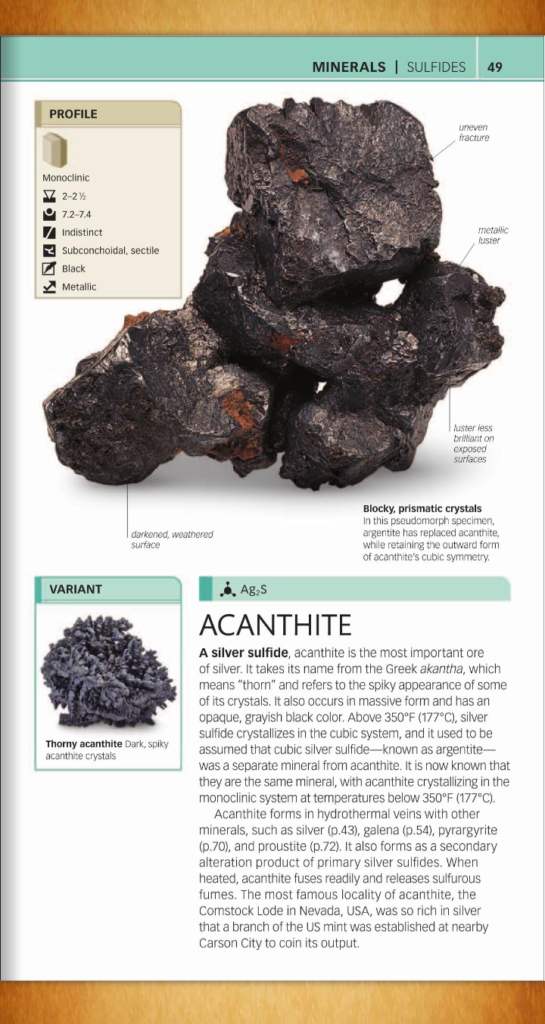Acanthite: A Detailed Overview of Silver Ore
Introduction
Acanthite is a mineral composed of silver sulfide (Ag₂S) and is a significant silver ore. It is one of the most important sources of silver, widely appreciated for its rich silver content. Acanthite forms as a low-temperature polymorph of argentite, another silver sulfide mineral, and is known for its dark, metallic appearance. This mineral has been mined for centuries due to its economic value and occurs in various regions worldwide, typically associated with other silver-rich ores.

Physical Properties of Acanthite
Understanding the physical properties of acanthite is critical for its identification and extraction. Some key properties include:
- Chemical Formula: Ag₂S
- Crystal System: Monoclinic
- Color: Dark gray to black
- Streak: Shiny, metallic-gray
- Luster: Metallic
- Mohs Hardness: 2 to 2.5 (relatively soft)
- Specific Gravity: 7.2 to 7.3 (very dense due to the high silver content)
- Cleavage: Poor
- Fracture: Subconchoidal to uneven
- Transparency: Opaque
Acanthite tends to exhibit a distorted, monoclinic crystal structure when found in nature, especially when formed at low temperatures. It is known for its high silver content, often accounting for more than 87% of its mass.
Formation and Occurrence
Acanthite forms under low-temperature conditions, typically below 179°C, where it crystallizes from argentite, its high-temperature polymorph. It is often found in hydrothermal veins, where it precipitates from hot, mineral-rich fluids. These fluids are often associated with volcanic or geothermal activity.
Formation Process:
- Hydrothermal Activity: Silver-bearing solutions form in the Earth’s crust due to volcanic activity or geothermal processes.
- Cooling and Precipitation: As these solutions cool, silver sulfide (Ag₂S) precipitates out, forming argentite. When the temperature drops further, it transforms into acanthite.
- Crystallization: Acanthite crystals form, either as free-standing crystals in vein systems or as part of a matrix with other minerals.
Associated Minerals:
Acanthite is often found in association with other silver and lead ores, such as:
- Galena (PbS)
- Pyrite (FeS₂)
- Chalcopyrite (CuFeS₂)
- Native silver
These minerals typically occur together in hydrothermal veins, making acanthite a key component of economically valuable ore bodies.
Geographic Distribution
Acanthite is found worldwide, but significant deposits are located in regions with a history of silver mining. Major mining locations include:
- Mexico: Known for its rich silver mines, particularly in states such as Zacatecas and Guanajuato.
- Peru: An ancient center of silver mining, acanthite is found in hydrothermal veins across the country.
- USA: States such as Colorado, Nevada, and Idaho have historically produced large amounts of silver from acanthite-bearing ore.
- Germany: The Freiberg mining district is famous for its historical silver mines.
- Canada: The Cobalt district in Ontario is notable for acanthite associated with native silver.
- Australia: Silver deposits in New South Wales and Victoria often contain acanthite.
Identification and Distinguishing Features
Acanthite can be identified through several key characteristics:
- Color and Luster: Its dark gray to black color and metallic luster make it distinguishable from other silver ores.
- Softness: With a Mohs hardness of 2 to 2.5, it is much softer than most other metallic minerals. This softness can be tested by scratching with a knife.
- High Density: The high specific gravity (7.2 to 7.3) is indicative of its silver content, making it much heavier than other minerals of the same size.
- Crystallography: Under microscopic analysis, its monoclinic crystal structure can be observed.
- Association with Silver: Acanthite is often found with native silver, making it relatively easy to identify when silver is present in the same geological setting.
Identification in the Field
In fieldwork, geologists use several simple methods to identify acanthite. The mineral’s metallic luster and density can be quickly tested, and its softness helps distinguish it from other sulfides like pyrite. X-ray diffraction (XRD) and scanning electron microscopy (SEM) may be used in more detailed laboratory analyses to confirm its identity.
Uses of Acanthite
Acanthite’s primary use is as an ore of silver. Silver extracted from acanthite is used in:
- Jewelry: Silver’s luster and malleability make it a popular choice for high-end jewelry.
- Coins: Historically, silver has been used to mint coins, and acanthite played a critical role in supplying silver for this purpose.
- Electronics: Due to its high electrical conductivity, silver is used in electronics and electrical components.
- Industrial Uses: Silver is also employed in mirrors, photographic films, and various industrial applications.
Conclusion
Acanthite is a vital mineral for silver mining, valued for its high silver content and ease of identification. Its occurrence in hydrothermal veins, association with other silver ores, and distinct physical properties make it a key mineral in the geology of silver deposits. Understanding its formation, characteristics, and economic value is essential for geologists, miners, and the silver industry.
This unique silver sulfide mineral continues to be mined in many parts of the world, providing an essential resource for various industries and maintaining its importance in the global economy.